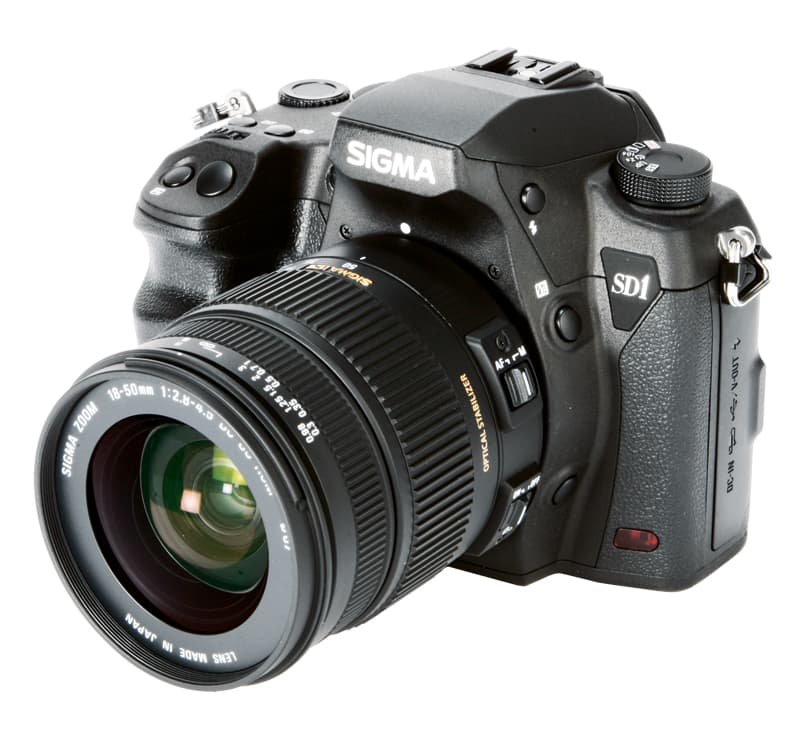Sigma SD1 at a glance:
- Foveon X3 sensor
- 46 million pixels (4704x3136x3)
- Magnesium-alloy, weather-sealed body
- ISO 100-6400
- Removable dust protector
- Street price £5,500
The imaging sensor of the Sigma SD1 is obviously the main feature, but there is a lot more to this camera. Compared to its predecessors, the SD1 is a completely overhauled model, although one would expect this of a camera four times the price of anything before it.
Given the cost of the SD1, it is very easy to feel underwhelmed by the camera at first glance, especially regarding the rather dated and modest 460,000-dot TFT colour LCD screen. However, once in the hand my opinion started to change. This is a beautifully weighted camera, complemented exquisitely by the contoured faux leather-faced hand grip. The magnesium-alloy body, which weighs just 700g and measures 145.5×113.5x80mm, features weather-sealed dials, buttons and joints to resist dust and moisture entering the camera.
The SD1 is not a conventional modern DSLR, as there is no direct control for video record or even live view. Another absentee is the top LCD screen for viewing exposure settings. I missed this a lot, especially in a fast-paced photo
shoot. Instead, these settings are viewed via the function button menu on the LCD screen or via the viewfinder (with 98% field of view and 0.95x magnification). Neither option is ideal when interacting with a model, though.
In place of the top LCD is the shooting mode dial, with PASM control and three custom user-defined settings. Aperture and shutter speed are controlled by the two unmarked dials, although by selecting either aperture or shutter priority mode both dials perform the same function.
To the top left side is a dial that turns the camera on, which doubles as a control for the drive mode with single, continuous and timed shooting. Also positioned here is the mirror lock-up and the auto bracketing mode.
Each button is large and spaced well apart from the next, so once the layout becomes familiar, changing settings while glued to the viewfinder is very possible. In fact, most buttons have a sole purpose, so memorising their functions is a little easier.
There are direct controls for exposure compensation, ISO (at a range of 100-6400), metering (four modes within the 77-segment system), 11-point autofocus mode (all of which are cross-type and individually selectable), auto exposure lock (AEL), flash exposure compensation and a single user-defined function button.
Other key controls such as white balance are accessed via the menus. Shooting menus are accessed either via the function menu button or quick set (QS). The latter is a little different in its navigation to most menus, but those unfamiliar with the system will not take long to become used to it.
With such large amounts of image data, the Dual True II engine and Advanced DDR III buffer have their work cut out. Capturing images is one thing, but for those wanting instant viewing the delay to clear the buffer to enable viewing requires a little extra patience. The fast-paced user may therefore find this a little frustrating. That said, the SD1 is no slouch for a fast capture, as it is capable of five frames per second (fps) up to a seven-frame capture burst.
Those familiar with the Sigma system will expect a dust protector, and indeed the SD1 features one. This is placed just inside the Sigma lens mount to repel dust and dirt from entering the camera.
Perhaps more excitingly, the dust protector doubles as an infrared (IR) light blocker and can be easily removed by hand, without tools, for cleaning. Bayer-type sensors have this built in to the low-pass filter or placed directly in front of the sensor but it is not removable. The handy benefit of the SD1’s system is that, by removing the dust protector, it allows infrared light to reach the sensor. When used with an R72 infrared filter placed in front of the lens, this allows for pure infrared images to be captured. This adds a unique dimension to shooting, and one that is not easily replicated in Photoshop. Meanwhile, turning a regular Bayer sensor camera into an infrared model is both costly and permanent.

Image: Pure infrared images can be captured with the SD1 by using an R72 filter in front of the lens
Verdict
There is no doubt that the Sigma SD1’s unique Foveon X3 sensor means that the final images from this camera in a variety of settings stand out from the other two models – for good and bad reasons. The SD1’s resolution detail at lower sensitivities is truly staggering, although it is no match for the 40-million-pixel 645D.
There is a clear gap between each of the three cameras in this investigation. Unfortunately, there are more areas where the SD1’s sensor falls short. Dynamic range is rather limited for a camera at this price range, and its ability to control levels of noise satisfactorily at higher sensitivities does not stretch higher than ISO 800.
Let us not forget just how expensive the SD1 is. In proportion to its overall quality, one would hope to pay around a third of its asking price. This is not a satisfactory alternative to a medium-format camera. To date, however, when used at ISO 100 and 200, the resolution of the SD1 is unmatched by cameras using a regular 14MP sensor.
Sigma has built on its previous flagship model, but the Foveon sensor still shows signs of flaws in certain areas of image quality and, as such, the SD1 is likely to please only a limited crowd.






